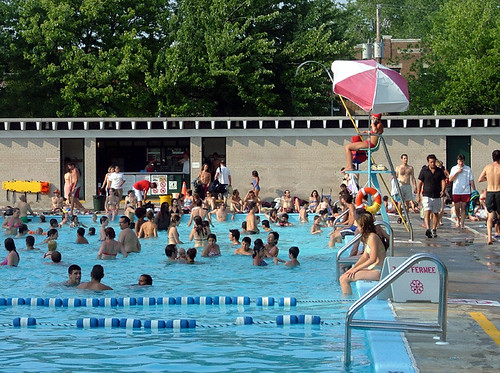If you want easy access to a good and spacious pool, you’re better off living in the west end or a demerged suburb, La Presse reported on Sunday. There’s nothing surprising there—that’s often the case with any kind of municipal service—but the disparity in pool access in different neighbourhoods is pretty astonishing:
Après avoir comparé le nombre d’habitants à celui des piscines des arrondissements et des villes reconstituées, on remarque que ces dernières sont nettement avantagées.
Les écarts sont énormes. Dans la petite municipalité de Senneville, on compte une piscine pour 967 habitants. Dans l’arrondissement de Ville-Marie, il n’y a qu’une seule piscine – à l’île Sainte-Hélène – pour 78 876 personnes!
En tête de peloton, huit villes reconstituées. Elles sont généralement riches et situées dans l’ouest de l’île, à l’exception de Montréal-Est. Tout en bas de la liste se trouvent huit arrondissements de Montréal.
Les arrondissements, maîtres-d’œuvreEn moyenne, dans les villes reconstituées, on trouve une piscine pour 10 253 habitants. Les arrondissements de Montréal en offrent trois fois moins : une piscine pour 32 252 habitants.
This might seem like a trivial matter, but pools are public spaces too, and they’re an especially valuable resource in poorer areas that lack many of the amenities of their wealthier counterparts. What’s interesting, though, is that the large number of pools on the West Island can be explained not only by their relative affluence but by the preponderance of privately-operated cooperative pools.
Au cours des années 60, les banlieues se sont multipliées dans l’ouest de l’île. En même temps que l’on créait des espaces verts, une quarantaine de piscines ont été construites. «À l’époque, les municipalités n’en ont pas voulu et ce sont des groupes de citoyens qui en ont hérité», explique Chris Vandersluis, président de l’Association aquatique Northshore.Les citoyens ont formé des coopératives autour d’une idée: créer, entre les banlieues, une culture aquatique communautaire. Les membres paient une contribution annuelle qui varie entre 150 et 300$ selon la piscine, en plus des frais d’adhésion. Ils ont droit à une foule d’activités et de cours. Les plus jeunes peuvent aussi se joindre à des équipes de natation, de plongeon ou de water-polo. «C’est un concept unique en Amérique du Nord», dit M. Vandersluis.
I’ve always wondered why so many parts of Montreal fare so poorly when it comes to recreational amenities like pools. Compared to Toronto, neighbourhood pools are few and far between and their operating hours are much shorter. Montreal’s pools don’t even stay open late during heat waves! Still, there are enough good public pools in this city to make for some pretty satisfying summer afternoons. La Presse has a list of the city’s best pools, including the Natatorium in Verdun, the little-known Royal Victoria Hospital pool and the pool on St. Helen’s Island. What’s your favourite place to swim?


2 comments
The pool in Parc Kent here in CDN, popular for many a summer, is still out of commission at present, having been torn up starting last fall apparently to install new concrete around it, and more plaza area. (Maybe new plumbing too, I dunno.) I’ve seen weeks go by this spring with little work done (occasional spurts of activity); it wasn’t ready for the hot spell we had a little while back, and I felt and still feel a bit angry on behalf of all the kids in the neighbourhood. Is it just me, or does the city have a consistent pattern of disorganization and delay in its public works reconstruction projects?
Are more of Toronto’s pools publicly operated compared to the ones in Montreal?